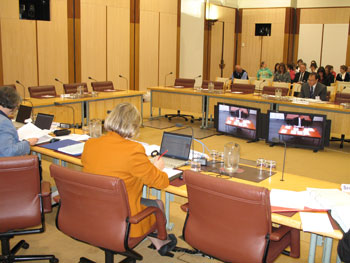General committee provisions
30 Meetings
-
The mover of a committee, if a member of it, shall fix the time for the first meeting of the committee; if the mover is not a member the secretary shall fix the time.
-
Notice of meetings subsequent to the first meeting shall be given by the secretary attending the committee:
-
pursuant to resolution of the committee;
-
on instruction of the chairman; or
-
upon a request by a quorum of members of the committee.
-
A committee is authorised to hold meetings by electronic communication without the members of the committee or witnesses being present in one place, provided that:
-
when a committee deliberates, members of the committee constituting a quorum are able to speak to, and hear, each other contemporaneously;
-
when a witness gives oral evidence, members of the committee constituting a quorum are able to hear the witness contemporaneously and to put questions to the witness in each other’s hearing; and
-
the chair of such a meeting takes care to ensure that a quorum is maintained during the meeting and that the standing orders and rules of the Senate are observed.
Amendment history
Adopted: 19 August 1903 as SO 289 (corresponding to paragraph (1)) but renumbered as SO 285 for the first printed edition
Amended:
-
20 August 1975, J.860 (and see 19 August 1975, J.852) (adoption of new SO 297A, corresponding to paragraph (2), providing methods for calling meetings after the first meeting)
-
13 February 1997, J.1447 (to take effect 24 February 1997) (paragraph (3) added – provisions relating to electronic meetings)
1989 revision: Old SOs 297 and 297A combined into one, structured as two paragraphs and renumbered as SO 30; repositioned from old chapter XXII on select committees; expression simplified and superfluous proviso removed
Commentary

The Community Affairs Legislation Committee taking evidence from a witness via teleconference ( Photo courtesy of AUSPIC)
Based on SO 352 of the South Australian House of Assembly, paragraph (1) included the innovation of providing for the committee clerk to call the first meeting if the mover of the motion to appoint the committee was not a member. What is now paragraph (2) was added in 1975 on the adoption of the Standing Orders Committee’s Second Report for Fifty–Sixth Session (PP No. 276/1974). Subparagraph (c) was clearly based on a provision included in opposition amendments to the resolution reappointing the legislative and general purpose standing committees in September 1974 which allowed meetings of those committees to be called by a quorum of members (see SO 25).
The 1989 revision involved no significant changes of content other than the removal of a superfluous proviso: “Provided that, in Committees consisting of less than seven Senators, the request is made by not less than three Members of the Committee”.
By the mid–1990s, it was relatively common for committees to take evidence by telephone or videoconference and for senators to participate from remote locations by the same means. In October 1995, the Procedure Committee reported on the broader issue of electronic meetings of committees.[1] The report examined the current practice which was that committees had been advised that they may allow members and witnesses to participate by electronic communication, provided that a quorum of the committee was physically present in one place. It was up to individual committees, under standing order 35(1), to determine the manner in which they would conduct inquiries, subject to other requirements in the standing orders, such as those relating to quorums, being met. The Procedure Committee alluded to possible legal uncertainties as being the reason for committees previously being advised to err on the side of caution, but it considered that committees should be able to conduct electronic meetings without a quorum present in one place and recommended to the Senate an addition to SO 30 in the terms of paragraph (3). If the Senate had explicitly authorised meetings of this nature, it was likely that a court would have regard to an authorising order in determining any doubt over the application of parliamentary privilege.
The recommendation was included in the Procedure Committee’s consolidation of the standing orders in its First Report of 1996 and adopted on 13 February 1997.[2]